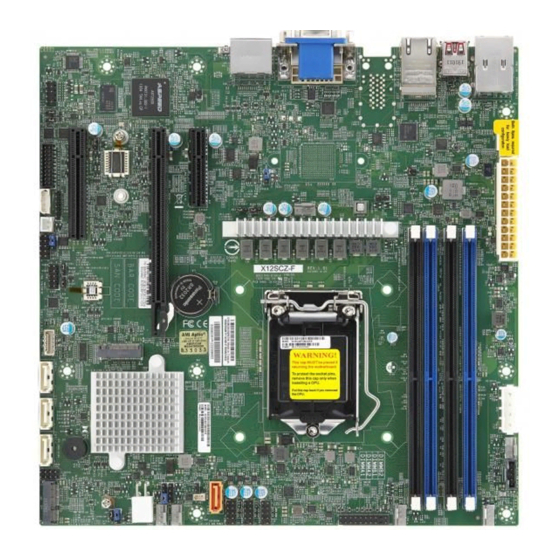
Table of Contents
Advertisement
Advertisement
Table of Contents

Summarization of Contents
Chapter 1 Introduction
Checklist
Lists essential components included in the retail package for system setup.
Processor and Chipset Overview
Details supported CPU types and motherboard chipsets (W480E/Q470E).
Special Features
Highlights unique motherboard functionalities like power loss recovery.
System Health Monitoring
Explains onboard monitoring of voltage, temperature, and fan status.
ACPI Features
Describes Advanced Configuration and Power Interface for power management.
Power Supply
Specifies power connector requirements and recommendations for stable operation.
Serial Port
Details the functionality and specifications of the motherboard's serial ports.
Chapter 2 Installation
Static-Sensitive Devices
Provides essential precautions for handling ESD-sensitive components to prevent damage.
Processor and Heatsink Installation
Step-by-step guide for installing the CPU and CPU heatsink with fan.
Motherboard Installation
Instructions for physically mounting the motherboard into a computer chassis.
Memory Support and Installation
Information on compatible memory modules and correct installation procedures.
Rear I/O Ports
Identifies and describes all the input/output ports located on the motherboard's rear panel.
Front Control Panel
Explains the purpose and pinouts of front panel connectors for chassis buttons and LEDs.
Connectors
Details various onboard connectors for power, fans, storage, and peripherals.
Jumper Settings
Explains the function and configuration of motherboard jumpers for system settings.
LED Indicators
Describes the meaning and status of various LEDs on the motherboard.
Chapter 3 Troubleshooting
Troubleshooting Procedures
Guides users through common system issues and diagnostic steps.
Technical Support Procedures
Outlines steps to take and information to provide when contacting technical support.
Frequently Asked Questions
Provides answers to common user inquiries regarding system functionality and BIOS.
Battery Removal and Installation
Step-by-step instructions for safely removing and installing the motherboard CMOS battery.
Returning Merchandise for Service
Details the process for returning products for warranty service or repair.
Chapter 4 UEFI BIOS
Introduction
An overview of the motherboard's Unified Extensible Firmware Interface (UEFI) BIOS utility.
Main Setup
Describes the primary screen of the BIOS utility and its configurable items.
Advanced Setup Configurations
Details the extensive range of advanced settings available within the BIOS for system configuration.
Event Logs
Configuration options for managing SMBIOS event logs and system boot events.
IPMI
Settings and configuration for the Intelligent Platform Management Interface (IPMI).
Security
Options for configuring system security, including BIOS passwords and secure boot.
Boot
Settings for managing boot modes, boot order, and boot options.
Save & Exit
Options for saving BIOS configuration changes and exiting the setup utility.
Appendix A BIOS Codes
BIOS Error POST (Beep) Codes
Lists common beep codes generated during POST for system error diagnosis.
Additional BIOS POST Codes
Provides links and information for further details on BIOS checkpoint codes.
Appendix B Software
Microsoft Windows OS Installation
Step-by-step guide for installing the Microsoft Windows operating system.
Driver Installation
Instructions on how to download and install necessary system drivers and utilities.
SuperDoctor® 5
Overview of SuperDoctor 5, a system health monitoring tool for Windows and Linux.
IPMI
Information on using the Intelligent Platform Management Interface (IPMI) for system management.
Appendix C Standardized Warning Statements
Battery Handling
Important safety warnings and instructions regarding the handling and replacement of batteries.
Appendix D UEFI BIOS Recovery
Overview
An introduction to the Unified Extensible Firmware Interface (UEFI) and its role in BIOS recovery.
Recovering the UEFI BIOS Image
Explains the process and components involved in recovering the UEFI BIOS image.
Recovering the BIOS Block with a USB Device
Detailed instructions on how to use a USB device for UEFI BIOS recovery.
















Need help?
Do you have a question about the X12SCZ-QF and is the answer not in the manual?
Questions and answers